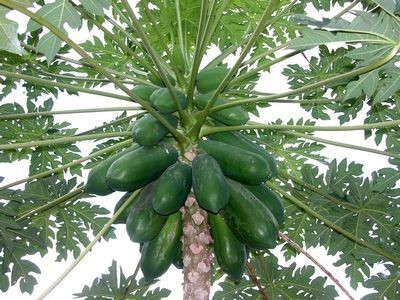
Common Name: Papita,
English Name: Melon Tree, Papaya
Botanical Name: Carica papaya L, Carica peltata Hook. & Arn., Carica posoposa L., Papaya carica Gaertn.
Family: Caricaceae
Description: Commonly and erroneously referred to as a "tree", the plant is properly a large herb growing at the rate of 6 to 10 ft (1.8-3 m) the first year and reaching 20 or even 30 ft (6-9 m) in height, with a hollow green or deep-purple stem becoming 12 to 16 in (30-40 cm) or more thick at the base and roughened by leaf scars. Though the exact area of origin is unknown, the papaya is believed native to tropical America, perhaps in southern Mexico and neighboring Central America.
Chemical Constituents: Main chemical components are papain, chymopapain, pectin, carposide, carpaine, pseudocarpaine, dehydrocarpines, carotenoids, cryptoglavine, cis-violaxanthin and antheraxanthin. fiber, ash, Ca, P, Fe, Na, K, beta-carotene equivalent, thiamine, riboflavin, niacin, and ascorbic acid. The leaves calories, protein, fat, carbohydrate, fiber, ash, Ca, P, Fe, Na, K, beta-carotene equivalent, thiamine, riboflavin, niacin, and ascorbic acid, as well vitamin E
Properties: Papaya fruit offers not only the luscious taste but is a rich source of antioxidant nutrients such as carotenes, vitamin C and flavonoids; the B vitamins, folate and pantothenic acid; and the minerals, potassium and magnesium; and fiber. Together, these nutrients promote the health of the cardiovascular system and also provide protection against colon cancer. The fruit is valued for its proteolytic enzymes including papain, which is used like bromelain, a similar enzyme found in pineapple, to treat sports injuries, other causes of trauma, and allergies. The milk like juice from unripe fruit called latex, contains the most concentration of papain, enough some people say to remove freckles.
Used in the following MATXIN product: